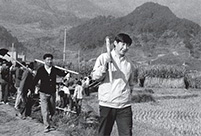 Top 100 beauties in the world!
Top 100 beauties in the world!
 Gallery: Who is the most beautiful one?
Gallery: Who is the most beautiful one?
 If you like autumn, put your hands in the air!
If you like autumn, put your hands in the air!
 Fan Bingbing's "Queen style" in new play
Fan Bingbing's "Queen style" in new play
 Lingerie show at 2014 Miss China
Lingerie show at 2014 Miss China
 J-10 fighters show aerobatic stunts in smog-free sky
J-10 fighters show aerobatic stunts in smog-free sky
 Charming contestants of Shanghai Int’l Model Contest
Charming contestants of Shanghai Int’l Model Contest
 Most amazing chi-pao beauties
Most amazing chi-pao beauties
 7 deadly animal attacks
Russia to launch 70 Proton rockets by 2020: official
7 deadly animal attacks
Russia to launch 70 Proton rockets by 2020: officialDALIAN, Nov. 15 -- Chinese archaeologists said they had discovered another important site of human activity dating back 300,000 to 500,000 years, roughly contemporary with Peking Man.
Dozens of stone, animal bone and horn tools have been excavated at a limestone quarry site in Luotuo Hill in the coastal city of Dalian, Liaoning Province.
Researchers have obtained more than 1,000 important samples since the joint excavation began in August by the Institute of Vertebrate Paleontology and Paleoanthropology of the Chinese Academy of Sciences and the Dalian Natural History Museum.
Stone tools and large herbivorous animal bones that appear to have been cut or smashed by humans show the site was an important site for early human activity, said Huang Weiwen, researcher with the institute, on Saturday.
Deer and antelope horn tools were also used at the Zhoukoudian Caves in Beijing's suburbs, where the skulls of Peking Man, or Homo erectus, were found in the 1920s and 1930s.
Peking Man was first believed to have lived in Zhoukoudian about 400,000 to 500,000 years ago. But some Chinese scientists later said they were actually 200,000 years older, probably from a mild glacial period.
"The discovery of the Luotuo Hill site of early human beings is of great significance," said Gao Chunling, deputy head of the Dalian natural museum.
It is likely to be the earliest cultural ruins in northeast China, making it important for the study of human evolution and the origin of culture in the region, said Gao.
Fossils of ancient mammals such as elephants, tigers and wild boars were also similar to those unearthed at Zhoukoudian, according to the researchers.
Yet no fossils of human bones or teeth have been unearthed at the site yet. The excavation work is still under way.
The local limestone geography, where cracks and water-eroded caves formed easily, provided a good location for the preservation of early human and mammal fossils, according to Liu Jinyuan, a paleontologist with the museum.
Workers are registering the unearthed samples for further study.
 Standard faces for each countries
Standard faces for each countries Photos: Xi Jinping in Fujian
Photos: Xi Jinping in Fujian China-made military transport aircraft gets ready
China-made military transport aircraft gets ready World Pole Dance Championship in China
World Pole Dance Championship in China Shocking! Photos of Chinese fighters revealed
Shocking! Photos of Chinese fighters revealed 59-year-old Liu Xiaoqing still looks stunning
59-year-old Liu Xiaoqing still looks stunning  In pics: PLA stages live-fire drill in NE China
In pics: PLA stages live-fire drill in NE China  Post-85s female pilots and their mission
Post-85s female pilots and their mission Netizens fall in love with champion swimmer Ning Zetao
Netizens fall in love with champion swimmer Ning Zetao Top 10 most dangerous jobs in the world
Top 10 most dangerous jobs in the world  Top 10 fifth generation jet fighters in the world
Top 10 fifth generation jet fighters in the world Top 10 Chinese goddesses
Top 10 Chinese goddesses  Top 20 hottest women in the world in 2014
Top 20 hottest women in the world in 2014 Top 10 pure beauties in showbiz
Top 10 pure beauties in showbiz  Top 10 world's highest-paid models 2014
Top 10 world's highest-paid models 2014 The most gorgeous Chinese women
The most gorgeous Chinese women Top 10 most handsome faces in Asia
Top 10 most handsome faces in AsiaDay|Week|Month